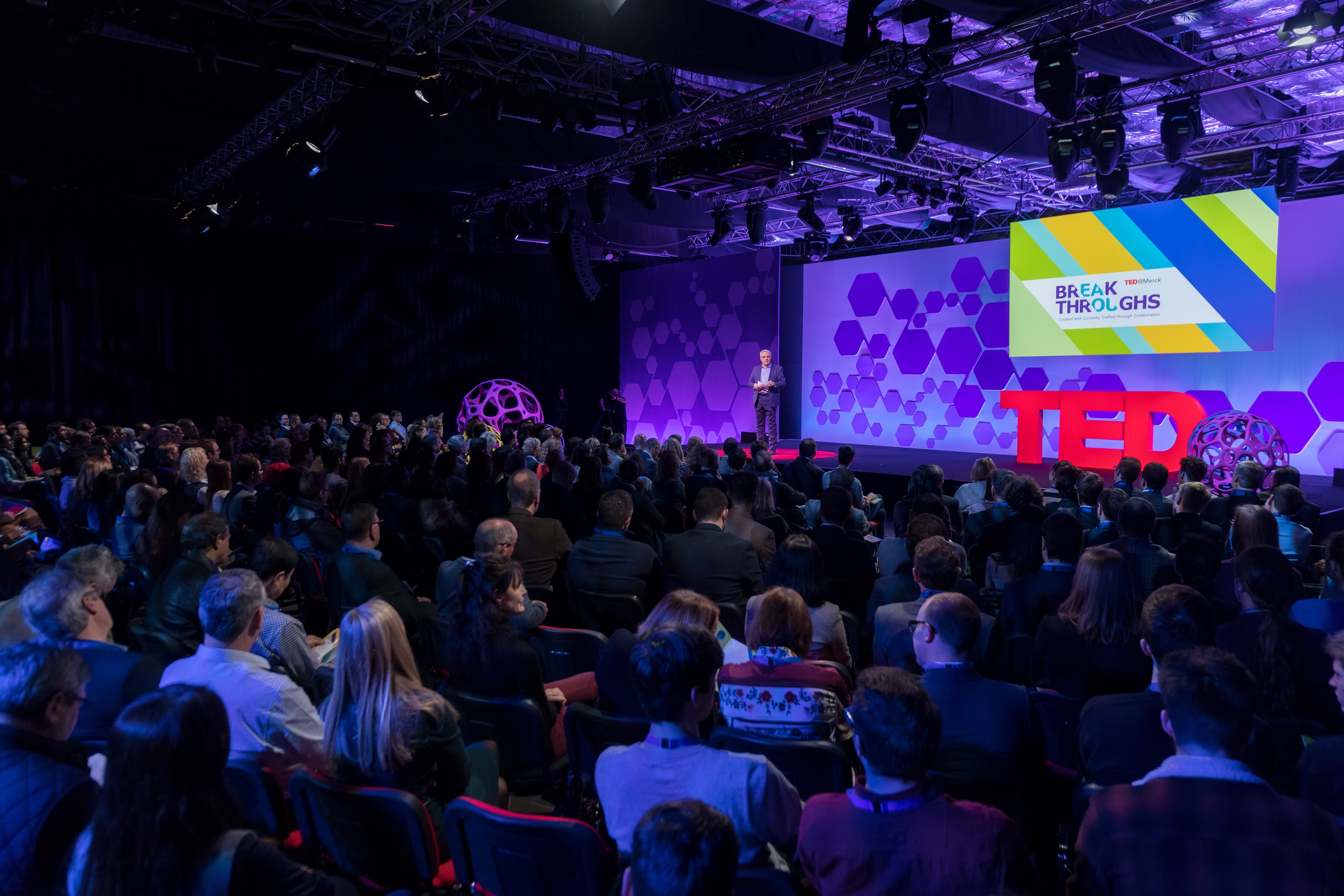
TED and Merck KGaA, Darmstadt, Germany, have partnered to help surface and share brilliant ideas, innovations — and breakthroughs. (Photo: Paul Clarke / TED)
Humanity is defined by its immense body of knowledge. Most times it inches forward, shedding light onto the mysteries of the universe and easing life’s endeavors in small increments. But in some special moments, knowledge and understanding leap forward, when one concentrated mind or one crucial discovery redirects the course of things and changes the space of possibilities.
TED and Merck KGaA, Darmstadt, Germany, have partnered to help surface and share brilliant ideas, innovations — and breakthroughs. At the inaugural TED@Merck KGaA, Darmstadt, Germany event, hosted by TED International Curator Bruno Giussani at Here East in London on November 28, 16 brilliant minds in healthcare, technology, art, psychology and other fields shared stories of human imagination and discovery.
After opening remarks from Belén Garijo, CEO, Healthcare for Merck KGaA, Darmstadt, Germany, the talks of Session 1 kicked off.
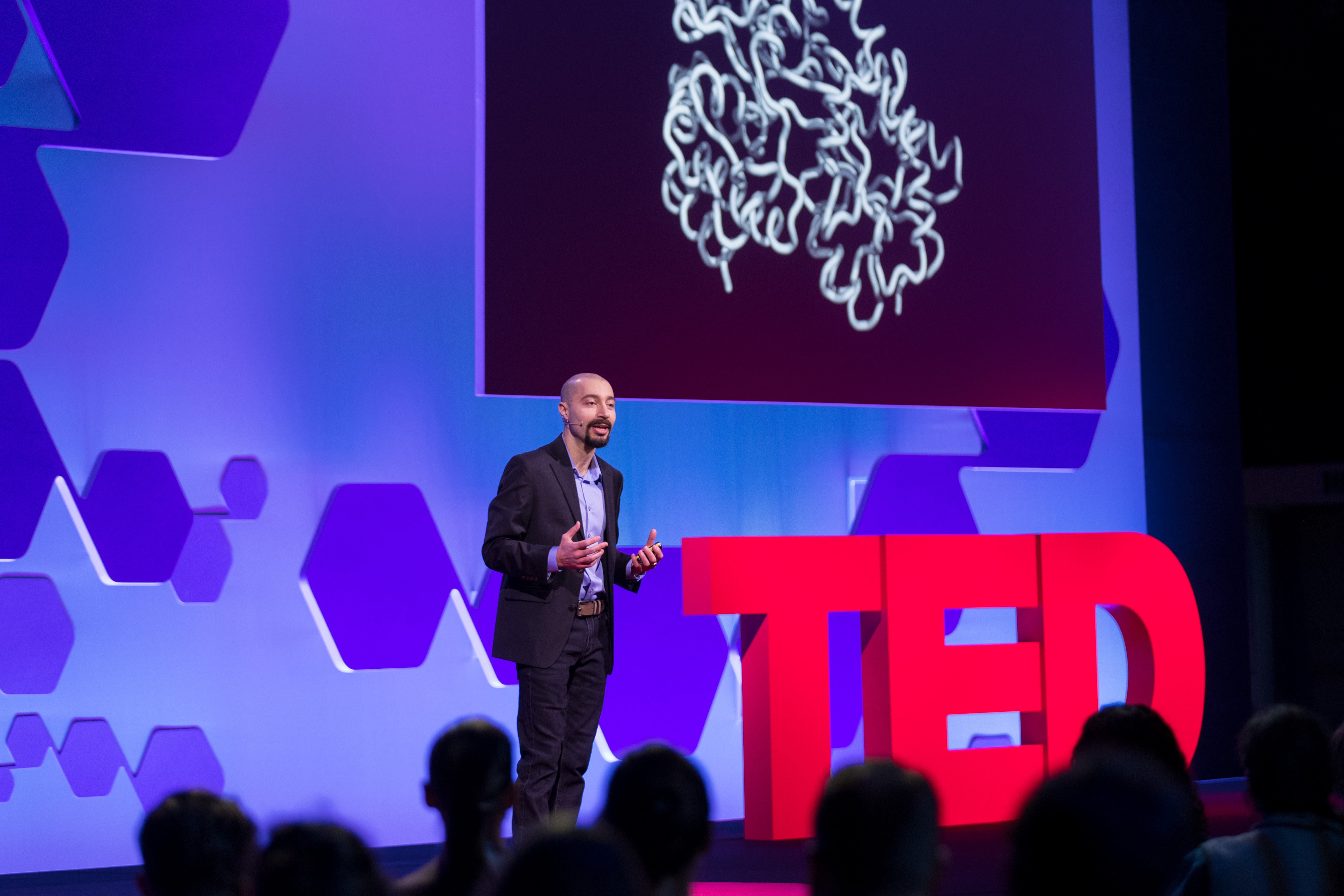
Biochemist Bijan Zakeri explains the mechanism behind a molecular superglue that could allows us to assemble new protein shapes. (Photo: Paul Clarke / TED)
A molecular superglue made from flesh-eating bacteria. The bacteria Streptococcus pyogenes — responsible for diseases including strep throat, scarlet fever and necrotizing fasciitis (colloquially, flesh-eating disease) — has long, hair-like appendages made of proteins with a unique property: the ends of these proteins are linked by an incredibly strong chemical bond. “You can boil them, try to cut them with enzymes or throw them in strong acids and bases. Nothing happens to them,” says biochemist Bijan Zakeri. Along with his adviser Mark Howarth, Zakeri figured out a way to engineer these proteins to create what he describes as a molecular superglue. The superglue allows us to assemble new protein shapes, and “you can chemically link the glue components to other organic and inorganic molecules, like medicines, DNA, metals and more, to build new nano-scale objects that address important scientific and medical needs,” Zakeri says.
What if we could print electronics? “We must manufacture devices in a whole new way, with the electronics integrated inside the object, not just bolted in afterwards,” says advanced technologist Dan Walker. He introduces us to his vision of the fast approaching future of technology, which could take two potential paths: “The first is hyper-scale production, producing electrically functional parts along the standard centralized model of manufacturing. Think of how we print newspapers, ink on paper, repeating for thousands of copies. Electronics can be printed in this way, too.” he says. Walker designs inks that conduct electricity and can be used to print functional electronics, like wires. This ink can be used in inkjet printers, the sort that can be found in most offices and homes. But these inkjet printers are still 2D printers — they can print the electronics onto the object, but they can’t print the object itself. “The second way the manufacturing world will go is towards marrying these two techniques of digital printing, inkjet and 3D, and the result will be the ability to create electrically functional objects,” Walker explain, both unique objects bespoke for individual customers and perfect replicas printed off by the thousands.
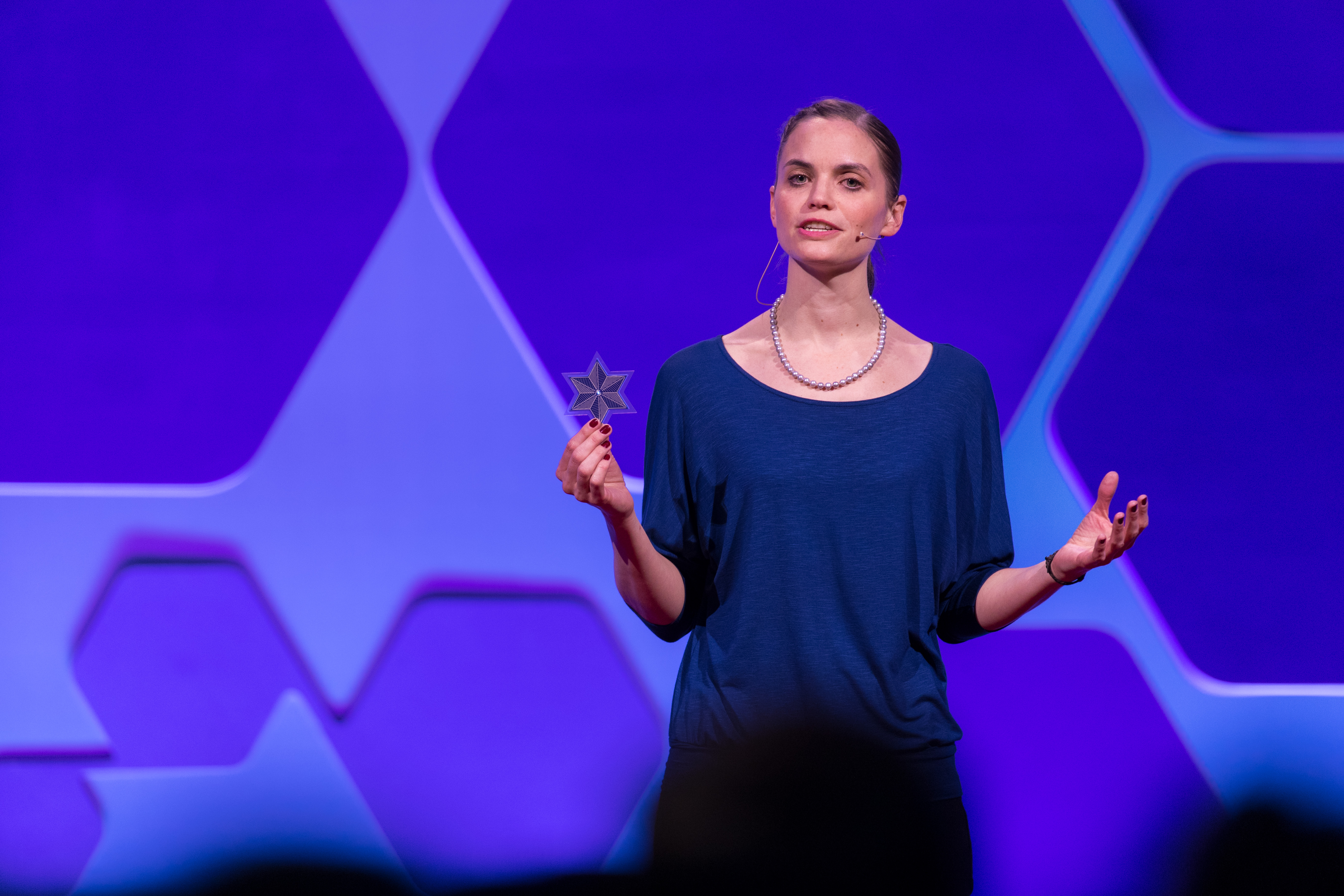
Strategic marketer Hannah Bürckstümmer explains her work developing organic photovoltaics — and how they might change how we power the world. (Photo: Paul Clarke / TED)
A printable solar cell. Buildings consume about 40 percent of our total energy, which means reducing their energy consumption could help us significantly decrease our CO2 emissions. Solar cells could have a big role to play here, but they’re not always the most aesthetically pleasing solution. Strategic marketer Hannah Bürckstümmer is working on a totally different solar cell technology: organic photovoltaics. Unlike the solar cells you’re used to seeing, these cells are made of compounds that are dissolved in ink and can be printed using simple techniques. The result is a thin film that absorbs the energy of the sun. The solar module looks like a plastic foil and is low weight, flexible and semi-transparent. It can be used in this form or combined with conventional construction materials like glass. “With the printing process, the solar cell can change its shape and design very easily,” Bürckstümmer says, displaying a cell onstage. “This will give the flexibility to architects, to planners and building owners to integrate this electricity-producing technology as they wish.” Plus, it may just help buildings go from energy consumers to energy providers.
A robot that can grab a tomato without crushing it. Robots are excellent at many tasks — but handling delicate items isn’t one of them. Carl Vause, CEO of Soft Robotics, suggests that instead of trying to recreate the human hand, roboticists should instead seek inspiration from other parts of nature. Consider the octopus: it’s very good at manipulating items, wrapping its tentacles around objects and conforming to their shapes. So what if we could get robots to act like an octopus tentacle? That’s exactly what a group of researchers at Harvard did: in 2009, they used a composite material structure, with rubber and paper, to create a robot that can conform to and grasp soft objects. Demoing the robot onstage, Vause shows it can pick up a bath sponge, a rubber duck, a breakfast scone and even a chicken egg. Why is this important? Because until now, industries like agriculture, food manufacturing and even retail have been largely unable to benefit from robots. With a robot that can grasp something as soft as a tomato, we’ll open up whole industries to the benefits of automation.
Departing from rules can be advantageous — and hilarious. In between jokes about therapy self-assessment forms, hair salons and box junctions, human nature explorer James Veitch questions the rules and formalities people are taught to respect throughout life. An avid email and letter writer, Veitch is unafraid and unapologetic in voicing his concerns about anyone whose actions fall in line with protocols but out of line with common sense. To this effect, he questions Jennifer, a customer relations team member at Headmasters Salon, as to why he and his friend Nige received comparable haircuts when they booked appointments with different types of stylists: Nige with a Senior Stylist (who cost 34 Euros) and Veitch with a Master Hair Consultant (who cost 54 Euros). Using percentages and mathematics, and even inquiring into the reasons why Nige received a biscuit and he didn’t, Veitch argues his way into a free haircut. Though Veitch is clearly enjoying himself by questioning protocols, he derives more than amusement from this process — as he shows us how departing from rules and formalities can be advantageous and hilarious, all at once.
If we can’t fight our emotions, why not use them? Emotions are as important in science as they are in any other part of our lives, says materials researcher Ilona Stengel. The combination of emotion and logical reasoning is crucial for facing challenges and exploring new solutions. Especially in the scientific world, feelings are just as necessary as facts and logic for paving the way to breakthroughs, discoveries and cutting-edge innovations. “We shouldn’t be afraid of using our feelings to implement and to catalyze fact-based science,” Stengel says. Stengel insists that having a personal, emotional stake in the work that you do can alter your progress and output in an incredibly positive way, that emotions and logic do not oppose, but complement and reinforce each other. She asks us all — whether we’re in or outside of the science world — to reflect on our work and how it might give us a sense of belonging, dedication and empowerment.
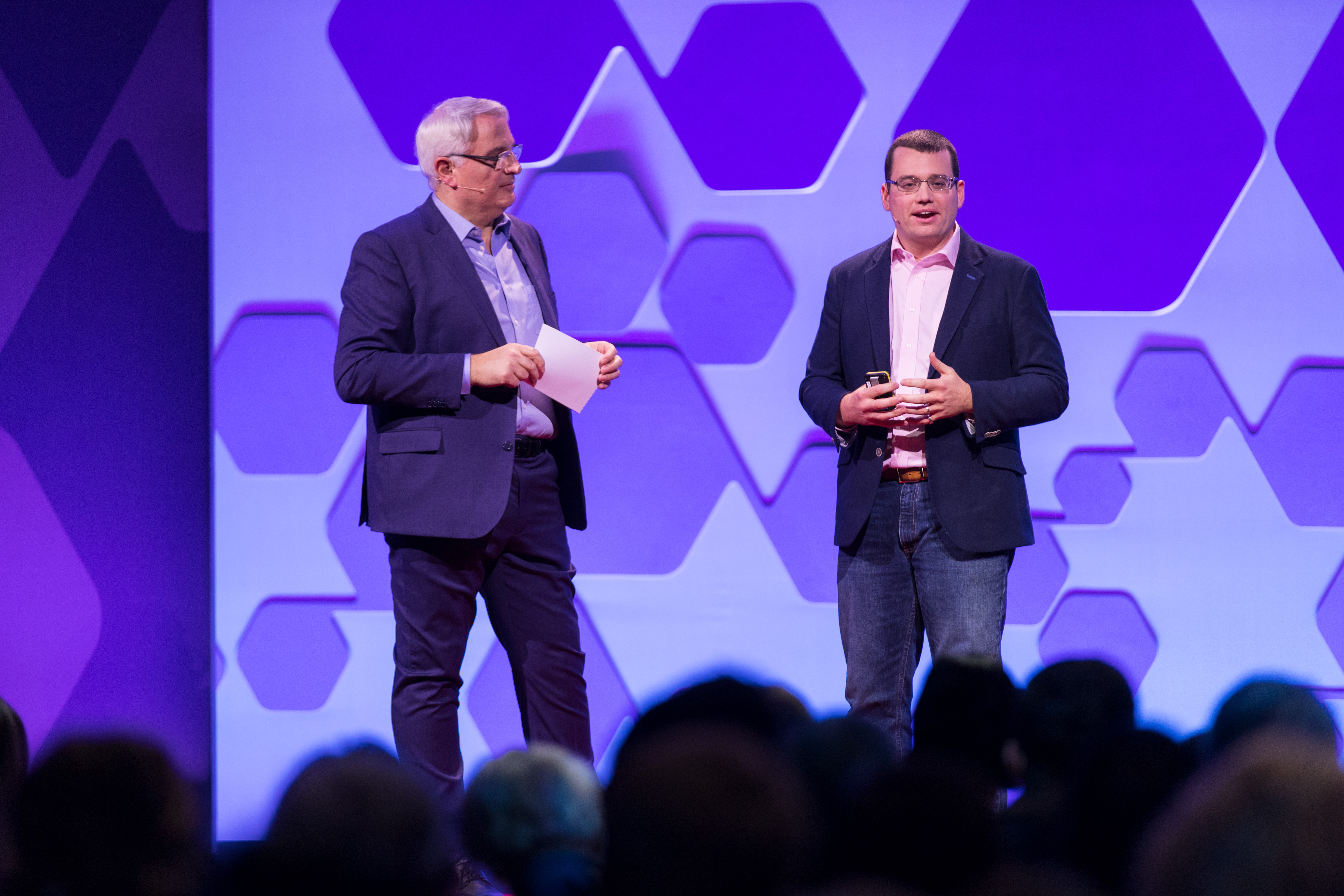
TED International Curator Bruno Giussani, left, speaks with Scott Williams about the important role informal caregivers play in the healthcare system. (Photo: Paul Clarke / TED)
Putting the “care” back in healthcare. Once a cared-for patient and now a caregiver himself, Scott Williams asks us to recognize the role that informal caregivers — those friends and relatives who go the extra mile out of love — play in healthcare systems. Although they don’t administer medication or create treatment plans for patients, informal caregivers are instrumental in helping people return to good health, Williams says. They give up their jobs, move into hospitals with patients, know patients’ medical histories and sometimes make difficult decisions for them. Williams suggests that without informal caregivers, “our health and social systems would crumble, and yet they’re largely going unrecognized.” He invites us to recognize their selfless work — and their essential value to the smooth functioning of healthcare systems.

Tiffany Watt Smith speaks about the fascinating history of how we understand our emotions. (Photo: Paul Clarke / TED)
Yes, emotions have a history. When we look to the past, it’s easy to see that emotions changed — sometimes very dramatically — in response to new cultural expectations and new ideas about gender, ethnicity, age and politics, says Tiffany Watt Smith, a research fellow at the Centre for the History of the Emotions at the Queen Mary University of London. Take nostalgia, which was defined in 1688 as homesickness and seen as being deadly. It last appeared as a cause of death on a death certificate in 1918, for an American soldier fighting in France during WWI. Today, it means something quite different — a longing for a lost time — and it’s much less serious. This change was driven by a shift in values, says Watt Smith. “True emotional intelligence requires we understand the social, political, cultural forces that have shaped what we’ve come to believe about our emotions and understand how they might still be changing now.”
Dispelling myths about the future of work. “Could machines replace humans?” was a question once pondered by screenwriters and programmers. Today, it’s on the minds of anybody with a job to lose. Daniel Susskind, a fellow in economics at Oxford University, kicked off Session 2 by tackling three misconceptions we have about our automated future. First: the Terminator myth, which says machines will replace people at work. While that might sometimes happen, Susskind says that machines will also complement us and make us more productive. Next, the intelligence myth, which says some tasks can’t be automated because machines don’t possess the human-like reasoning to do them. Susskind dispels this by explaining how advances in processing power, data storage and algorithms have given computers the ability to handle complex tasks — like diagnosing diseases and driving cars. And finally: the superiority myth, which says technological progress will create new tasks that humans are best equipped to do. That’s simply not true, Susskind says, since machines are capable of doing different kinds of activities. “The threat of technological unemployment is real,” he declares, “Yet it is a good problem to have.” For much of our history, the biggest problem has been ensuring enough material prosperity for everyone; global GDP lingered at about a few hundred dollars per person for centuries. Now it is $10,150, and its growth shows no signs of stopping. Work has been the traditional way in which we’ve distributed wealth, so how should we do it in a world when there will be less — or even no — work? That’s the question we really need to answer.
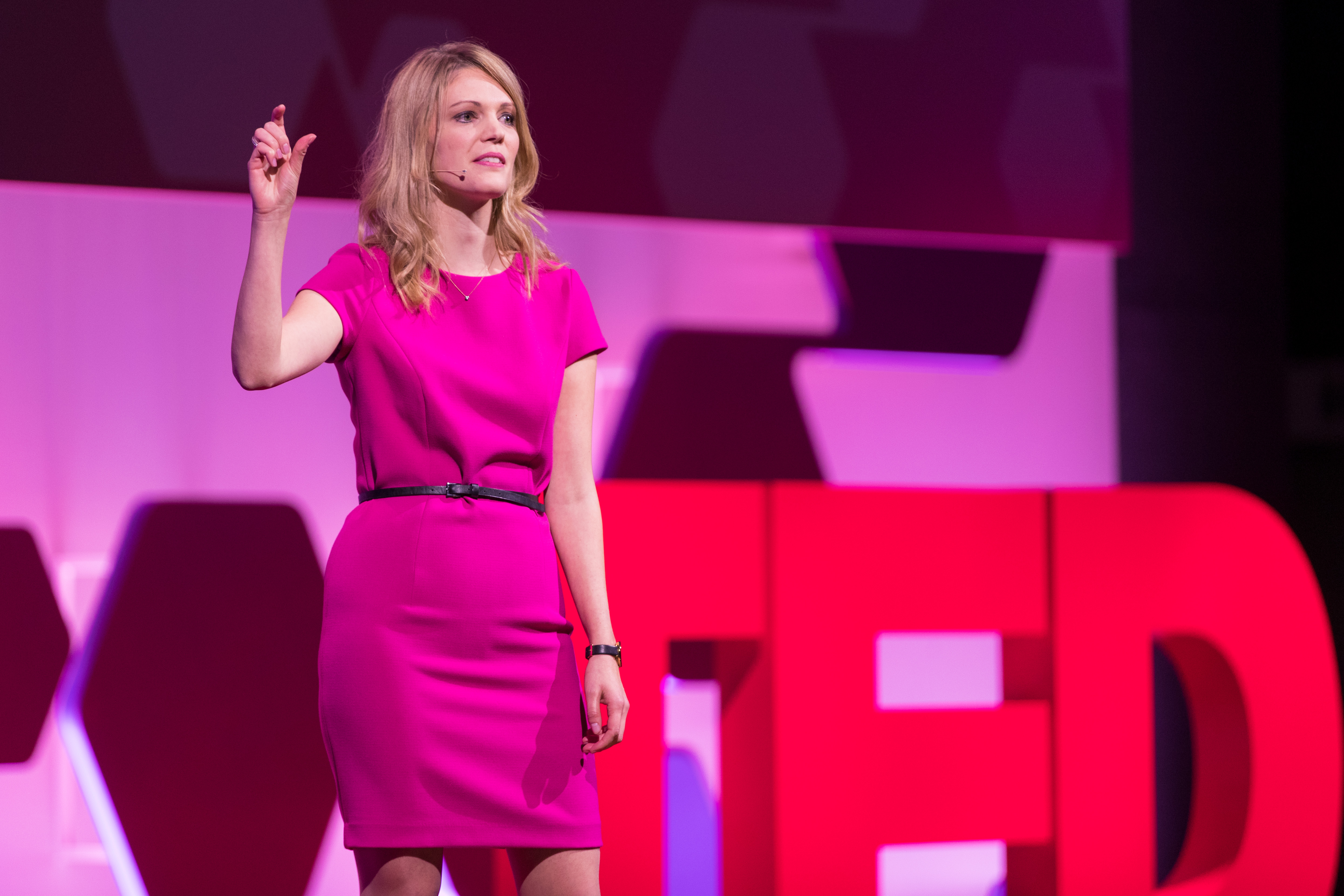
A happy company is a healthy company, says transformation manager Lena Bieber. She suggests that we factor in employee happiness when we think about — and invest in — companies. (Photo: Paul Clarke / TED)
Investing in the future of happiness. Can financial parameters like return on equity, cash flow or relative market share really tell us if a company is fundamentally healthy and predict its future performance? Transformation manager Lena Bieber thinks we should add one more indicator: happiness. “I would like to see the level of happiness in a company become a public indicator — literally displayed next to their share price on their homepages,” she says. With the level of happiness so prominent, people could feel more secure in the investments they’re making, knowing that employees of certain companies are in good spirits. But how does one measure something so subjective? Bieber likes the Happy Planet Index (a calculation created by TED speaker Nic Marks), which uses four variables to measure national well-being — she suggests that it can be translated for the workplace to include factors such as average longevity on the job and perceived fairness of opportunities. Bieber envisions a future where we invest not just with our minds and wallets, but with hearts as well.
Seeing intellectual disability through the eyes of a mom. When Emilie Weight’s son Mike was diagnosed with fragile X syndrome, an intellectual disability, it changed how she approached life. Mike’s differences compelled her to question her inner self and her role in the world, leading her to three essential tools that she now benefits from. Mindfulness helps her focus on the positive daily events that we often overlook. Mike also reminds Emilie of the importance of time management to use the time that she has instead of chasing it. Lastly, he’s taught her the benefit of emotional intelligence through adapting to the emotions of others. Emilie believes in harnessing the powers of people with intellectual disabilities: “Intellectually disabled people can bring added value to our society,” she says, “Being free of the mental barriers that are responsible for segregation and isolation, they are natural-born mediators.”
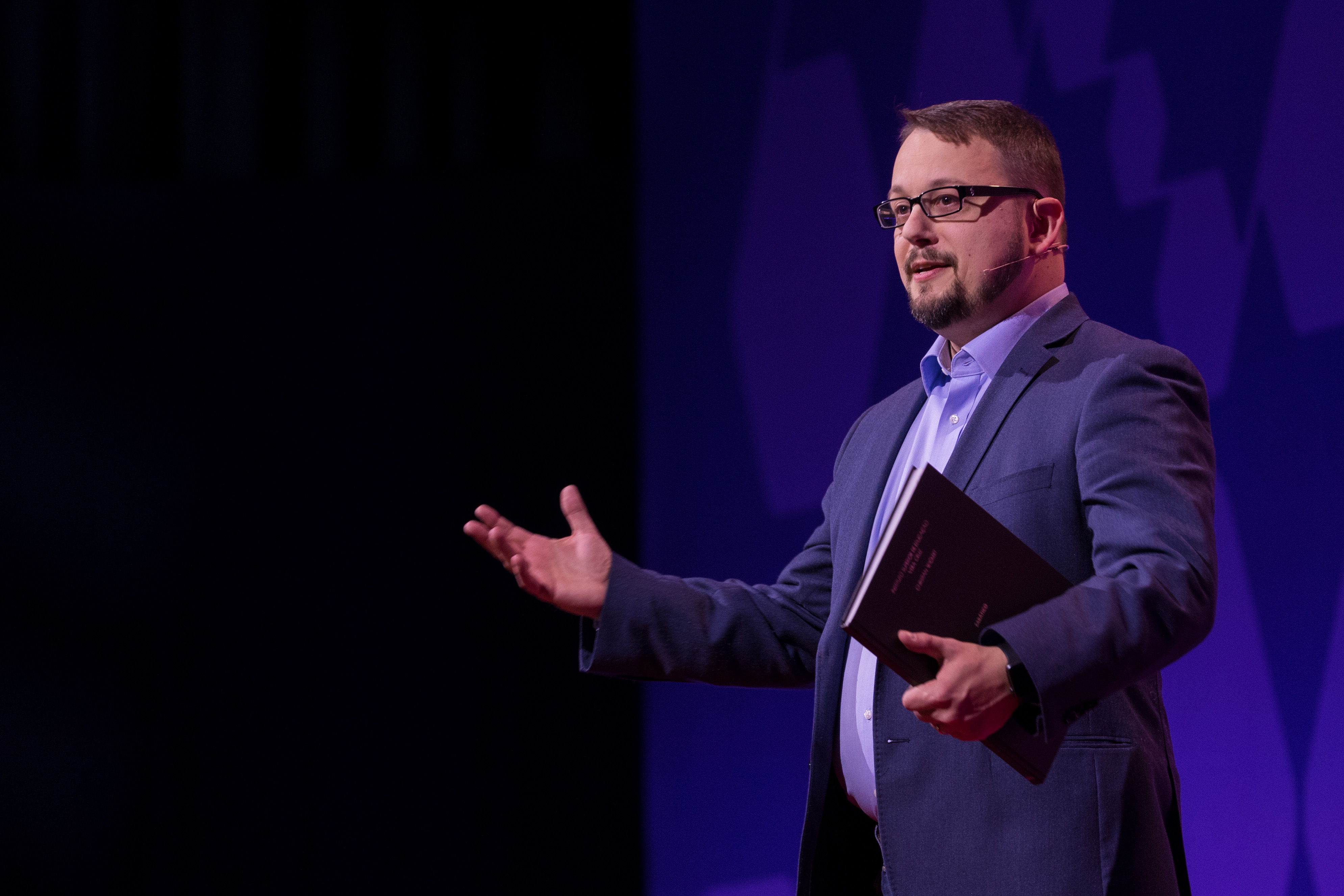
Christian Wickert suggests three ways that we can tap into the power of fiction — and how it could benefit our professional lives. (Photo: Paul Clarke / TED)
Can fiction make you better at your job? Forget self-help books; reading fiction might be the ticket to advancing your career. Take it from Christian Wickert, an engineer focusing on strategy and policy, who took a creative writing course — a course, he believes, that sharpened his perception, helped him understand other people’s motivations, and ultimately made him better at his job. Wickert explores three ways fiction can improve your business skills. First, he says, fiction helps you identify characters, their likes, dislikes, habits and traits. In business, this ability to identify characters can give you tremendous insights into a person’s behavior, telling you when someone is playing a role versus being authentic. Second, fiction reminds us that words have power. For example, “sorry” is a very powerful word, and when used appropriately it can transform a situation. Finally, fiction teaches you to look for a point of view — which in business is the key to good negotiation. So the next time you have a big meeting coming up, Wickert concludes, prepare by writing — and let the fiction flow.
How math can help us answer questions about our health. Mathematician Irina Kareva translates biology into mathematics, and vice versa. As a mathematical modeler, she doesn’t think about what things are but instead about what things do — about relationships between individuals, whether they’re cells, animals or people. Take an example: What do foxes and immune cells have in common? They’re both predators, except foxes feed on rabbits and immune cells feed on invaders, such as cancer cells. But from a mathematical point of view, the same system of predator-prey equations will describe both interactions between foxes and rabbits and cancer and immune cells. Understanding the dynamics between predator and prey — and the ecosystem they both inhabit — from a mathematical point of view could lead to new insights, specifically in the development of drugs that target tumors. “The power and beauty of mathematical modeling lies in the fact that it makes you formalize in a very rigorous way what we think we know,” Kareva says. “It can help guide us as to where we should keep looking, or where there might be a dead end.” It all comes down to asking the right question, and translating it to the right equation, and back.
End-to-end tracking of donated medicine. Neglected tropical diseases, or NTDs, are a diverse group of diseases that prevail in tropical and subtropical conditions. Globally, they affect more than one billion people. A coalition of pharmaceutical companies, governments, health organizations, charities and other partners, called Uniting to Combat Neglected Tropical Diseases, is committed to fighting NTDs using donated medicines — but shipping them to their destination poses complex problems. “How do we keep an overview of our shipments and make sure the tablets actually arrive where they need to go?” asks Christian Schröter, head of Pharma Business Integration at Merck KGaA, Darmstadt, Germany. Currently, the coalition is piloting a shipping tracker for their deliveries — similar to the tracking you receive for a package you order online — that tracks shipments to the first warehouse in recipient countries. This year, they took it a step further and tracked the medicines all the way to the point of treatment. “Still, many stakeholders would need to join in to achieve end-to-end tracking,” he says. “We would not change the amount of tablets donated, but we would change the amount of tablets arriving where they need to go, at the point of treatment, helping patients.”
Why we should pay doctors to keep people healthy. Most healthcare systems reimburse doctors based on the kind and number of treatments they perform, says business developer Matthias Müllenbeck. That’s why when Müllenbeck went to the dentist with a throbbing toothache, his doctor offered him a $10,000 treatment (which would involve removing his damaged tooth and screwing an artificial one into his jaw) instead of a less expensive, less invasive, non-surgical option. We’re incentivizing the wrong thing, Müllenbeck believes. Instead of fee-for-service health care, he proposes that we reimburse doctors and hospitals for the number of days that a single individual is kept healthy, and stop paying them when that individual gets sick. This radical idea could save us from unnecessary costs and risky procedures — and end up keeping people healthier.
The music of TED@Merck KGaA, Darmstadt, Germany. During the conference, music innovator Tim Exile wandered around recording ambient noises and sounds: a robot decompressing, the murmur of the audience, a hand fumbling with tape, a glass of sparkling water being poured. Onstage, he closes out the day by threading together these sounds to create an entirely new — and strangely absorbing — piece of electronic music.